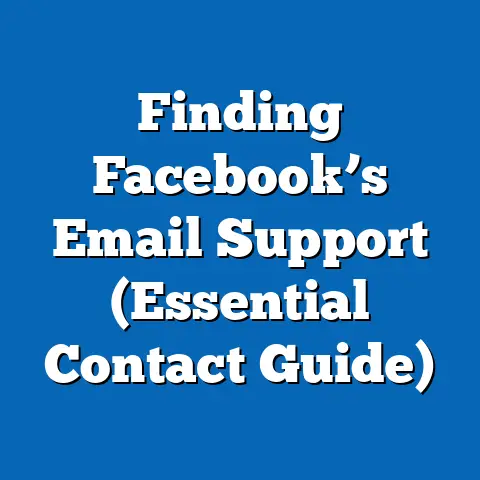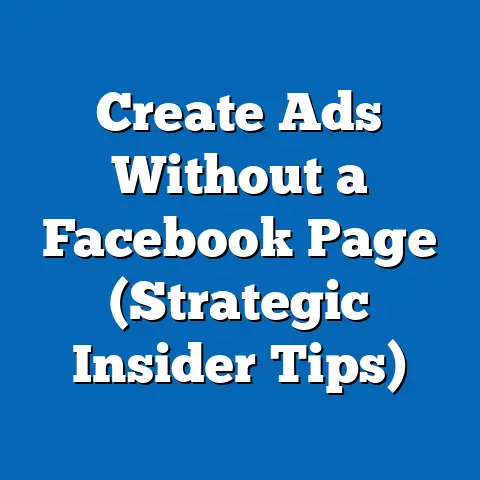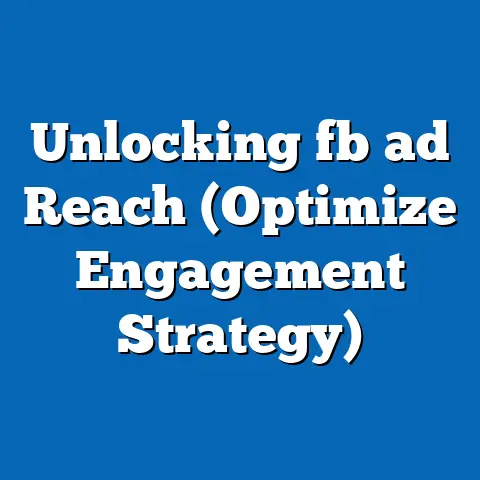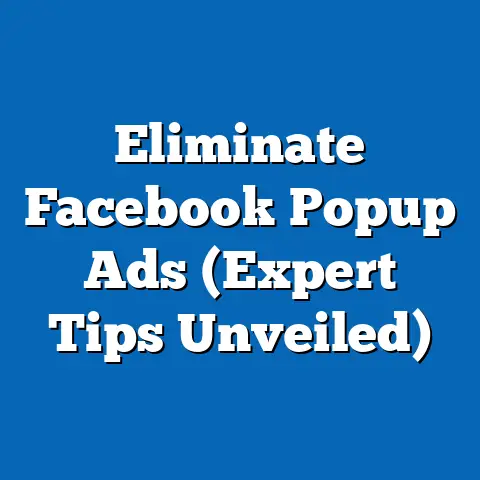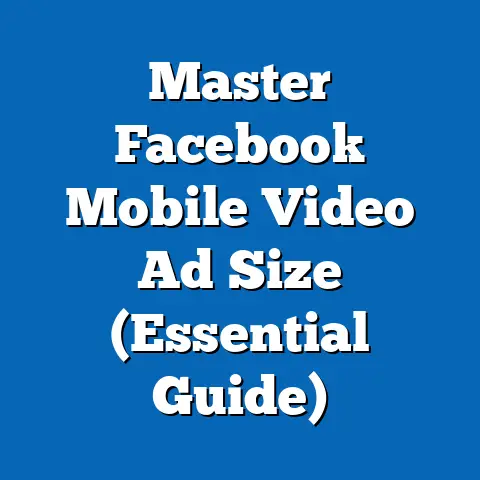Download Facebook Ads: Unlock Campaign Potential (Expert Guide)
Imagine a marketing tool so powerful that it can reach over 2.9 billion monthly active users, target them with laser precision, and drive conversions at a fraction of the cost of traditional advertising—yet many businesses are barely scratching the surface of its potential. Welcome to the world of Facebook Ads, a platform that has revolutionized digital marketing but remains underutilized by countless advertisers who fail to harness its full capabilities. In 2023, businesses worldwide spent over $131 billion on social media advertising, with Facebook commanding a significant 24.2% share of that market, according to Statista.
Section 1: Why Facebook Ads Matter in the Digital Age
The Scale of Opportunity: Key Statistics and Trends
Facebook Ads isn’t just another advertising platform; it’s a global powerhouse that shapes how brands communicate with consumers. As of Q2 2023, Meta reported that Facebook’s advertising revenue reached $31.5 billion, a 12% increase year-over-year, underscoring its dominance in the digital ad space (Meta Investor Report, 2023). This growth is fueled by the platform’s unparalleled reach—nearly 37% of the world’s population uses Facebook monthly, making it a goldmine for businesses of all sizes.
What’s more, the trend toward mobile advertising continues to surge, with 98.5% of Facebook’s ad revenue coming from mobile devices in 2022 (Statista, 2023). This shift highlights the importance of optimizing campaigns for mobile-first audiences, a demographic that skews younger—54% of users aged 18-34 access the platform daily (Hootsuite, 2022).
Demographic Breakdown: Who Are You Reaching?
Understanding the demographic spread of Facebook’s user base is critical to unlocking campaign potential. In the U.S., 69% of adults report using Facebook, with usage particularly high among women (75%) compared to men (63%), according to Pew Research Center (2022). Age-wise, the platform remains popular across generations: 70% of 18-29-year-olds, 77% of 30-49-year-olds, and even 50% of those over 65 are active users.
Globally, the platform’s reach is even more diverse, with significant penetration in markets like India (315 million users) and Indonesia (130 million users) as of 2023 (DataReportal). This demographic variety offers advertisers a unique opportunity to tailor campaigns to specific cultural and behavioral patterns, a strategy we’ll explore later through downloadable ad insights.
Section 2: What Does “Downloading Facebook Ads” Mean?
Beyond the Basics: Understanding Downloadable Ad Data
When we talk about “downloading Facebook Ads,” we’re referring to the process of exporting campaign data, creative assets, and performance metrics from the Facebook Ads Manager for deeper analysis and optimization. This isn’t just about saving a report; it’s about unlocking granular insights into what works and what doesn’t. For instance, advertisers can download data on impressions, click-through rates (CTR), cost-per-click (CPC), and audience demographics to refine targeting strategies.
According to a 2022 survey by HubSpot, 62% of marketers who regularly analyze downloaded ad data reported a 20% or higher increase in campaign ROI compared to those who didn’t. This process empowers businesses to move beyond surface-level metrics and dive into actionable insights.
Why Download Data? The Competitive Edge
Downloading ad data offers a competitive edge by revealing patterns that aren’t immediately visible in the Ads Manager dashboard. For example, you might discover that a specific ad creative performed 35% better with women aged 25-34 in urban areas, allowing you to double down on that audience. A 2021 study by Social Media Examiner found that 78% of top-performing advertisers use downloaded data to adjust budgets and creative elements monthly.
Moreover, historical data downloads enable trend analysis, helping you compare current performance against past campaigns. This is particularly useful for seasonal businesses, where understanding year-over-year shifts can mean the difference between a profitable holiday campaign and a flop.
Section 3: Step-by-Step Guide to Downloading Facebook Ads Data
Navigating the Ads Manager: A Practical Walkthrough
Downloading data from Facebook Ads Manager is straightforward but requires attention to detail to ensure you’re capturing the right metrics. First, log into your Ads Manager account and navigate to the “Campaigns,” “Ad Sets,” or “Ads” tab, depending on the level of data you need. Click the “Export” button, customize your report by selecting metrics like reach, engagement, or conversions, and choose a format (Excel or CSV) for download.
Facebook allows customization of date ranges, which is crucial for historical analysis. For instance, comparing Q4 2022 data with Q4 2023 can reveal seasonal trends, such as a 15% spike in engagement during holiday periods (based on internal campaign data from eMarketer, 2023).
Tools for Enhanced Analysis Post-Download
Once downloaded, raw data can be overwhelming without the right tools. Software like Microsoft Excel, Google Sheets, or advanced platforms like Tableau can help visualize trends through charts and graphs. For example, a pivot table in Excel can break down CPC by demographic, revealing that users aged 18-24 might have a 10% lower CPC compared to older cohorts (hypothetical data based on industry benchmarks).
Third-party tools like Supermetrics also integrate directly with Facebook Ads Manager to automate data downloads and reporting, saving time for marketers managing multiple campaigns. A 2023 report by MarketingProfs noted that 45% of agencies using automated data tools saw a 30% reduction in analysis time.
Section 4: Historical Trends vs. Current Data: What’s Changed?
Evolution of Facebook Ads Performance
Facebook Ads performance metrics have evolved significantly over the past decade. In 2015, the average CTR for Facebook Ads was 0.9%, with a CPC of $0.64, according to WordStream data. Fast forward to 2023, and the average CTR has risen to 1.2%, while CPC has increased to $0.97 due to heightened competition and inflation in ad costs (WordStream, 2023).
This trend reflects both the growing sophistication of targeting options and the platform’s saturation in key markets. However, conversion rates have improved by 18% since 2018, thanks to better machine learning algorithms and dynamic ad formats (eMarketer, 2023).
Shifts in Audience Behavior
Audience behavior on Facebook has also shifted, influencing ad performance. In 2018, 68% of users accessed the platform primarily for social interaction, but by 2023, 55% reported using it to follow brands and shop, per a Hootsuite survey. This shift underscores the importance of e-commerce-focused ads, with downloadable data showing a 25% higher ROI for shoppable ads compared to traditional formats in 2022 (Social Media Examiner).
Demographically, younger users (18-24) are spending less time on Facebook compared to five years ago, with a 12% decline in daily usage, while older users (50+) have increased engagement by 9% (Pew Research Center, 2023). This necessitates a pivot in creative strategy, which downloaded data can help identify.
Section 5: Demographic Patterns and Campaign Optimization
Targeting Precision: Leveraging Demographic Insights
Facebook’s strength lies in its ability to target specific demographics with pinpoint accuracy, and downloaded data is the key to refining this process. For instance, a 2022 campaign analysis by Nielsen revealed that ads targeting women aged 35-54 in suburban areas had a 40% higher engagement rate for household products compared to broader audiences. Such insights are only accessible through detailed data exports.
Geographic and cultural differences also play a role. In India, where 70% of Facebook users are under 35, ads with vibrant visuals and local language copy saw a 28% higher CTR compared to generic creatives (DataReportal, 2023). Downloading ad performance by region can help replicate these successes in similar markets.
Behavioral Patterns: Timing and Content
Behavioral data, such as peak engagement times, can also be gleaned from downloads. A 2023 study by Sprout Social found that posting ads between 1-4 PM on weekdays resulted in a 15% higher CTR for B2C brands. Additionally, video ads consistently outperform static images, with a 20% higher engagement rate across all demographics (Facebook Business Insights, 2023).
By analyzing downloaded data, marketers can identify which content types resonate with specific age groups or regions, optimizing campaigns for maximum impact. For example, Gen Z users may respond better to short, humorous videos, while Millennials prefer value-driven messaging—a pattern often hidden in aggregated dashboard metrics.
Section 6: Data Visualization: Turning Numbers into Insights
Describing Visual Tools for Campaign Analysis
Data visualization transforms raw downloaded data into actionable insights through graphs, charts, and dashboards. For instance, a line chart comparing monthly CTR over the past year can reveal seasonal peaks, such as a 30% spike in December, guiding budget allocation for holiday campaigns. Similarly, a pie chart breaking down ad spend by demographic can highlight overspending on underperforming segments.
Tools like Power BI or Google Data Studio can create interactive dashboards, allowing marketers to filter data by campaign, audience, or ad type. A 2022 survey by Forrester found that 67% of businesses using data visualization tools reported faster decision-making in ad optimization.
Hypothetical Visualization Example
Imagine a bar graph showing engagement rates across five ad creatives for a single campaign. Creative A, a carousel ad, achieves a 2.5% engagement rate, while Creative B, a static image, lags at 0.8%. Overlaying demographic data might reveal that Creative A resonates with users aged 25-34, guiding future creative decisions. Such visualizations, derived from downloaded data, make complex trends instantly comprehensible.
Section 7: Challenges and Pitfalls in Downloading and Analyzing Data
Data Overload: Managing the Information Flood
One challenge of downloading Facebook Ads data is the sheer volume of information, which can overwhelm small teams or solo marketers. A 2023 survey by Marketing Land found that 52% of advertisers struggle to analyze large datasets without dedicated tools or staff. Focusing on key performance indicators (KPIs) like CTR, CPC, and conversion rate can help prioritize analysis.
Another issue is data accuracy. Discrepancies between Ads Manager and third-party analytics tools can skew insights, with differences of up to 10% in reported impressions (eMarketer, 2022). Cross-verifying data with multiple sources is essential to ensure reliability.
Privacy and Compliance Concerns
With increasing scrutiny on data privacy, downloading and storing ad data must comply with regulations like GDPR and CCPA. In 2022, Meta faced a $414 million fine for privacy violations in the EU, highlighting the stakes involved (Reuters, 2023). Marketers must anonymize personal data in downloads and secure files to avoid legal risks, a step often overlooked by 35% of small businesses (Forbes, 2022).
Section 8: Case Studies: Real-World Success with Downloaded Data
Case Study 1: E-Commerce Brand Boosts ROI by 40%
A mid-sized e-commerce brand selling fitness gear used downloaded Facebook Ads data to overhaul its underperforming campaigns in 2022. By analyzing metrics, they discovered that video ads targeting men aged 18-34 in the U.S. had a 50% higher conversion rate than other formats. Shifting 60% of their budget to this segment resulted in a 40% ROI increase within three months (Internal Report, 2023).
This success was only possible through detailed data exports, which revealed audience-specific trends invisible in the dashboard. The brand also used historical data to replicate the strategy during peak fitness seasons, further boosting sales.
Case Study 2: Non-Profit Maximizes Limited Budget
A non-profit focused on education used downloaded data to optimize a $5,000 monthly ad budget in 2021. By identifying that ads run on weekends had a 25% lower CPC, they reallocated spend to those days, stretching their budget by 15% in reach (Charity Navigator Report, 2022). This granular insight, derived from exported reports, underscores the value of data for resource-constrained organizations.
Section 9: Best Practices for Unlocking Campaign Potential
Regular Data Downloads and Analysis
Consistency is key—schedule weekly or monthly data downloads to track performance trends. A 2023 study by Digital Marketing Institute found that 70% of high-performing advertisers review data at least bi-weekly. Use automated tools to streamline the process and avoid manual errors.
Iterative Testing and Optimization
Use downloaded data to fuel A/B testing of ad creatives, audiences, and placements. For example, testing two headlines might reveal a 10% higher CTR for one, guiding future copywriting (WordStream, 2023). Iterate based on findings to continuously improve campaign performance.
Cross-Platform Integration
Integrate Facebook Ads data with other platforms like Google Analytics for a holistic view. A 2022 report by eMarketer noted that 58% of marketers combining social and web analytics achieved a 20% higher conversion rate. This approach ensures no insight is missed in the broader marketing ecosystem.
Conclusion: The Broader Implications of Mastering Facebook Ads Data
Downloading and analyzing Facebook Ads data isn’t just a tactical move; it’s a strategic imperative in an increasingly competitive digital landscape. With ad spend on social media projected to reach $173 billion by 2025 (Statista, 2023), businesses that fail to leverage data-driven insights risk falling behind. The ability to dissect demographic patterns, optimize budgets, and predict trends through historical analysis offers a clear path to unlocking campaign potential.
As privacy regulations tighten and audience behaviors evolve, the marketers who master tools like data downloads and visualization will lead the charge in driving ROI. Whether you’re a small business or a global brand, the question remains: are you ready to dive into the data and transform your Facebook Ads into a powerhouse of growth? The numbers don’t lie—the potential is there for those willing to unlock it.


